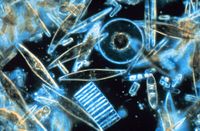
Photo from wikipedia
Mixed-layer depth (MLD) has been widely linked to phytoplankton dynamics in Antarctica's coastal regions; however, inconsistent definitions have made intercomparisons among region-specific studies difficult. Using a data set with over… Click to show full abstract
Mixed-layer depth (MLD) has been widely linked to phytoplankton dynamics in Antarctica's coastal regions; however, inconsistent definitions have made intercomparisons among region-specific studies difficult. Using a data set with over 20,000 water column profiles corresponding to 32 Slocum glider deployments in three coastal Antarctic regions (Ross Sea, Amundsen Sea, and West Antarctic Peninsula), we evaluated the relationship between MLD and phytoplankton vertical distribution. Comparisons of these MLD estimates to an applied definition of phytoplankton bloom depth, as defined by the deepest inflection point in the chlorophyll profile, show that the maximum of buoyancy frequency is a good proxy for an ecologically relevant MLD. A quality index is used to filter profiles where MLD is not determined. Despite the different regional physical settings, we found that the MLD definition based on the maximum of buoyancy frequency best describes the depth to which phytoplankton can be mixed in Antarctica's coastal seas.
Journal Title: Geophysical Research Letters
Year Published: 2017
Link to full text (if available)
Share on Social Media: Sign Up to like & get
recommendations!